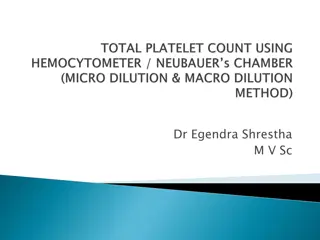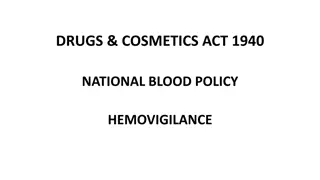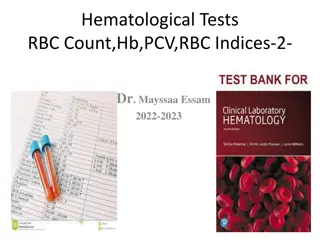Understanding WBC Differential Count in Blood Analysis
WBC (white blood cell) count is essential in assessing a patient's health. A differential count helps determine the percentage of different types of white blood cells. This analysis can provide important insights into various health conditions like infections, allergies, and systemic illnesses. The procedure involves examining stained blood films under a microscope to identify and count different leukocytes. Knowing the normal values and interpreting the differential count can aid in diagnosing specific diseases. Leucocytosis, neutrophilia, eosinophilia, and lymphocytosis are examples of conditions indicated by abnormal differential counts.
Download Presentation

Please find below an Image/Link to download the presentation.
The content on the website is provided AS IS for your information and personal use only. It may not be sold, licensed, or shared on other websites without obtaining consent from the author. Download presentation by click this link. If you encounter any issues during the download, it is possible that the publisher has removed the file from their server.
E N D
Presentation Transcript
WBC A white blood cell (WBC) count determines the concentration of white blood cells in the patient's blood. A differential determines the percentage of each of the five types of mature white blood cells
WBC Differential count 1. Automatic using Coulter counter 2. Manual Using Slide and microscope
Reagents and apparatus A microscope with an oil immersion objective Mineral or cedar wood oil Various dyes for staining blood films (e.g., Leishman's stain) Microscope slides
Procedure Examine the stained blood film under the oil immersion objective and identify the different leucocytes. Make colour diagrams of these cells. Count at least 100 leucocytes and record your findings in the table below. Express your results as the percentage of the total white blood cells identified.
Cells Number of cells % Neutrophils 59 40-60% Eosinophils 3 1-4% Basophils 1 0.5-1% Monocytes 5 2-8% Lymphocytes 32 20-40% Total 100 100%
Clinical Application Leucocytosis: High WBC count, in infection, allergy, systemic illness, inflammation, tissue injury. Differential count provides clues about certain illnesses 1. Neutrophilia: pyogenic illness 2. Eosinophilia: Allergy 3. Lymphocytosis: infectious mononucleosis
OBJECTIVES At the end of this lesson student should be able: to identify the different types of leucocytes under the microscope using theoretical knowledge of the histological characteristics of these cells. To practice the procedure for differential leucocytes counting. To know the normal values expected for the differential white cell count. To understand the use of the differential white cell count in the diagnosis of disease processes. 1. 2. 3. 4.

















































